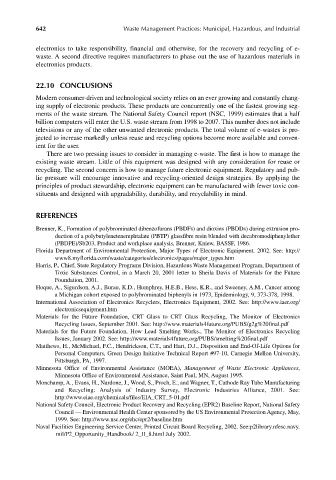Page 671 - Materials Chemistry, Second Edition
P. 671
CAT3525_C22.qxd 1/27/2005 1:00 PM Page 642
642 Waste Management Practices: Municipal, Hazardous, and Industrial
electronics to take responsibility, financial and otherwise, for the recovery and recycling of e-
waste. A second directive requires manufacturers to phase out the use of hazardous materials in
electronics products.
22.10 CONCLUSIONS
Modern consumer-driven and technological society relies on an ever growing and constantly chang-
ing supply of electronic products. These products are concurrently one of the fastest growing seg-
ments of the waste stream. The National Safety Council report (NSC, 1999) estimates that a half
billion computers will enter the U.S. waste stream from 1998 to 2007. This number does not include
televisions or any of the other unwanted electronic products. The total volume of e-wastes is pro-
jected to increase markedly unless reuse and recycling options become more available and conven-
ient for the user.
There are two pressing issues to consider in managing e-waste. The first is how to manage the
existing waste stream. Little of this equipment was designed with any consideration for reuse or
recycling. The second concern is how to manage future electronic equipment. Regulatory and pub-
lic pressure will encourage innovative and recycling-oriented design strategies. By applying the
principles of product stewardship, electronic equipment can be manufactured with fewer toxic con-
stituents and designed with upgradability, durability, and recyclability in mind.
REFERENCES
Brenner, K., Formation of polybrominated dibenzofurans (PBDFs) and dioxins (PBDDs) during extrusion pro-
duction of a polybutylenetenerephtalate (PBTP) glassfibre resin blended with decabromodiphenylether
(PBDPE)/Sb203, Product and workplace analysis, Brenner, Kniew, BASSF, 1986.
Florida Department of Environmental Protection, Major Types of Electronic Equipment. 2002. See: http://
www8.myflorida.com/waste/categories/electronics/pages/major_types.htm
Harris, P., Chief, State Regulatory Programs Division, Hazardous Waste Management Program, Department of
Toxic Substances Control, in a March 20, 2001 letter to Sheila Davis of Materials for the Future
Foundation, 2001.
Hoque, A., Sigurdson, A.J., Burau, K.D., Humphrey, H.E.B., Hess, K.R., and Sweeney, A.M., Cancer among
a Michigan cohort exposed to polybrominated biphenyls in 1973, Epidemiology, 9, 373-378, 1998.
International Association of Electronics Recyclers, Electronics Equipment, 2002. See: http://www.iaer.org/
electronicsequipment.htm
Materials for the Future Foundation, CRT Glass to CRT Glass Recycling, The Monitor of Electronics
Recycling Issues, September 2001. See: http://www.materials4future.org/PUBS/g2g%20final.pdf
Materials for the Future Foundation, How Lead Smelting Works., The Monitor of Electronics Recycling
Issues, January 2002. See: http://www.materials4future.org/PUBS/smelting%20final.pdf
Matthews, H., McMichael, F.C., Hendrickson, C.T., and Hart, D.J., Disposition and End-Of-Life Options for
Personal Computers, Green Design Initiative Technical Report #97-10, Carnegie Mellon University,
Pittsburgh, PA, 1997.
Minnesota Office of Environmental Assistance (MOEA), Management of Waste Electronic Appliances,
Minnesota Office of Environmental Assistance, Saint Paul, MN, August 1995.
Monchamp, A., Evans, H., Nardone, J., Wood, S., Proch, E., and Wagner, T., Cathode Ray Tube Manufacturing
and Recycling: Analysis of Industry Survey, Electronic Industries Alliance, 2001. See:
http://www.eiae.org/chemicals/files/EIA_CRT_5-01.pdf
National Safety Council, Electronic Product Recovery and Recycling (EPR2) Baseline Report, National Safety
Council — Environmental Health Center sponsored by the US Environmental Protection Agency, May,
1999. See: http://www.nsc.org/ehc/epr2/baseline.htm
Naval Facilities Engineering Service Center, Printed Circuit Board Recycling, 2002. See:p2library.nfesc.navy.
mil/P2_Opportunity_Handbook/ 2_II_8.html July 2002.

